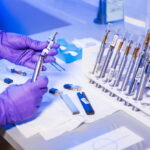In today’s digital age, the way we work has changed—especially in fields like radiology, where technology allows specialists to read and interpret images from anywhere in the country. While this remote model of care has made it easier to bring expertise to underserved and rural communities, it’s also introduced new leadership challenges. Building and maintaining trust within a team is no longer about face-to-face interaction in a hospital corridor or daily huddles in a shared reading room. It requires intention, empathy, and a modern approach to leadership.
Remote radiology is here to stay. But to make it work well—for doctors, for hospitals, and for patients—leaders need to rethink how they show up. Trust is no longer assumed; it must be earned and maintained through consistent presence, purposeful communication, and cultural awareness. Organizations like The Radiology Group have embraced this reality, creating leadership structures that keep teams connected, motivated, and aligned, even when physically apart.
The Shift to Remote Radiology and What It Means for Leadership
The shift to remote radiology has been both a technological and cultural evolution. Years ago, a radiologist had to be physically present in a hospital to interpret imaging studies. Today, with advanced PACS systems, secure high-speed networks, and robust imaging software, radiologists can review cases from home offices, rural workstations, or even across state lines. This has enabled coverage of hospitals that once struggled to attract subspecialists, especially in rural areas.
But this shift has come with a catch. Radiologists may now work in isolation, no longer engaging in the day-to-day interactions that once fostered camaraderie, mentorship, and shared problem-solving. Leadership can begin to feel distant or disconnected, and radiologists may feel like they are operating as individual units rather than as part of a cohesive team.
When leaders are not present—physically or emotionally—trust begins to erode. That’s when communication falters, misunderstandings grow, and morale begins to slip. In a specialty like radiology, where decisions must be accurate, timely, and collaborative, this kind of erosion can impact more than just team culture. It can influence patient care.
Leadership in a Distributed Model: It’s About Being Present, Even When Remote
Effective leadership in a remote radiology team starts with being present—digitally, emotionally, and professionally. Being present doesn’t require a leader to be online 24/7 or micromanaging every case. Instead, it means being responsive, consistent, and accessible. Team members need to know they can reach out, that their concerns will be heard, and that leadership understands the unique stressors of remote clinical work.
At The Radiology Group, leadership presence is built through structured communication systems and a culture of availability. Weekly check-ins, accessible messaging platforms, and open feedback channels ensure that radiologists don’t feel like they’re working in a vacuum. When leadership takes the time to ask how people are doing—not just how many studies they’ve read—it sends a clear message: people matter here.
This kind of presence also means celebrating wins, recognizing hard work, and showing appreciation in visible ways. A quick message of thanks, a public acknowledgment of excellent work, or simply checking in during a tough week can go a long way in building a sense of trust and loyalty.
Purpose as a Unifying Force
One of the most powerful tools remote leaders have is purpose. When people are united around a common goal, the need for constant oversight fades. They become intrinsically motivated, knowing that their work matters not just to a spreadsheet, but to a mission.
Radiologists in rural and underserved communities often operate with a deep sense of purpose. They know that their reads can be the difference between early diagnosis and delayed care. Leadership in this space must continually reinforce that mission and connect each team member’s work to the bigger picture.
The Radiology Group was founded with the goal of bringing high-quality radiology services to rural hospitals—places often overlooked or deprioritized by larger healthcare systems. By staying true to this mission and reminding their team why they do what they do, they’ve built a sense of pride and purpose that helps maintain trust and engagement, even across physical distance.
Communication: The Lifeline of Remote Trust
Without casual hallway conversations or lunchroom chats, remote teams rely heavily on structured communication. But effective communication in remote leadership isn’t just about frequency—it’s about tone, transparency, and consistency.
Leaders should be clear about expectations, but also flexible in how those expectations are met. They should share updates regularly, not just about performance metrics, but about company goals, challenges, and successes. When team members feel informed, they’re more likely to feel included—and trust that leadership is steering the ship with clarity.
In organizations like The Radiology Group, technology plays a big role in making this happen. The use of secure, HIPAA-compliant messaging tools allows for fast and direct communication between radiologists and leadership. But the platform is only half the equation. What matters just as much is the culture of openness and approachability that leadership fosters through those channels.
Trust Is Built in the Small Moments
Remote leadership is about more than big gestures or grand strategy. Trust is built in the small, daily choices leaders make: responding to a question promptly, listening without judgment, admitting when they don’t have all the answers, or simply remembering to ask about someone’s family or weekend.
These small acts of presence add up. They create a sense of psychological safety—where team members feel they can be themselves, speak up, and take risks without fear of embarrassment or retaliation. That safety is foundational to trust, especially in high-stakes environments like radiology.
Leading with Purpose and Presence
As more radiology practices embrace a remote-first model, leadership must evolve. Old models built on proximity no longer work. What’s needed now is a model built on empathy, visibility, and intentional communication.
Organizations that get this right—like The Radiology Group—aren’t just building efficient systems. They’re building communities. Communities where radiologists feel connected to each other, committed to a shared mission, and supported by leadership that shows up, listens, and leads with heart.
The future of radiology is undoubtedly remote, but that doesn’t mean it has to feel distant. With purpose and presence, remote leadership can be just as powerful—if not more so—than anything that came before it
Did you find this helpful? Check out our other helpful articles on our website.
Read Also
- Creative Approaches to Alleviating Healthcare Staff ShortagesHospitals and clinics are facing staff shortages, which makes it harder to take care of patients well. Finding simple and useful solutions is very important. Easy changes like flexible work hours, good training, and chances to grow can help staff stay happy. Technology, like online doctor visits and helpful tools, can make work easier. Smart… Read more: Creative Approaches to Alleviating Healthcare Staff Shortages
- Understanding the Role of Sterilizers in Healthcare FacilitiesHave you ever wondered how hospitals keep their equipment safe enough to use on dozens of patients every day? Most people never think about what happens behind the scenes, yet these hidden steps play a huge role in patient safety. Sterilizers are part of that system, working quietly to remove harmful germs before any instrument… Read more: Understanding the Role of Sterilizers in Healthcare Facilities
- Building Healthcare Access Where It’s Needed Most: A Local First ApproachHealthcare shouldn’t depend on where you live. But in the U.S., it often does. If you’re in a big city, you likely have options. If you’re in a small town or an underserved neighbourhood, it’s a different story. To fix this, more healthcare leaders are turning to a local-first approach. That means putting clinics and… Read more: Building Healthcare Access Where It’s Needed Most: A Local First Approach
- Revolutionizing Patient Engagement: Innovative Solutions for Improved Care and Treatment SuccessNavigating healthcare system can often feel overwhelming for patients. Between appointments, prescriptions, and treatment regimens, it’s easy for crucial details to get lost in the shuffle. That’s why effective patient engagement and support solutions are more important than ever. Companies like Serva Health, with their pharma hub services, are stepping up to ensure that patients… Read more: Revolutionizing Patient Engagement: Innovative Solutions for Improved Care and Treatment Success
- On-Demand Healthcare Staffing As A Cost-Saving StrategyThis is an exciting and challenging time for the healthcare industry. Technology is advancing almost faster than humans can keep pace. New legislation is creating fresh challenges for the future of healthcare, and the shifting population demographic continues to place more pressure on healthcare facilities. Amidst these changes, healthcare facilities are facing a critical staffing… Read more: On-Demand Healthcare Staffing As A Cost-Saving Strategy
- The Benefits of Contract Labor Staffing in HealthcareThe most successful healthcare facilities today aren’t just reacting to crises—they are building workforce resilience to withstand them. Unpredictable patient demand, coupled with persistent nursing shortages, has made the traditional staffing model obsolete. Relying on mandatory overtime to cover a sudden surge in capacity is a recipe for high turnover and rising employee burnout relief… Read more: The Benefits of Contract Labor Staffing in Healthcare
- Management Reinforcement for Healthcare Providers in a Shifting SystemHealthcare is changing faster than ever. So, providers are feeling the pressure to keep up. New technology, changing patient needs, and constant rule updates make it tough for managers to stay on top. Strong leadership helps teams work better, give great care, and stay happy in their jobs. Here’s how healthcare leaders can strengthen their… Read more: Management Reinforcement for Healthcare Providers in a Shifting System
- Why Effective Disinfection Remains the Foundation of Public HealthFrom hospitals and schools to transport hubs and food production sites, disinfection is central to breaking the chain of infection and protecting community health. The COVID-19 pandemic highlighted how crucial surface hygiene and environmental control are in reducing the spread of harmful microorganisms. Yet, beyond emergency response, routine and validated disinfection practices remain the cornerstone… Read more: Why Effective Disinfection Remains the Foundation of Public Health









